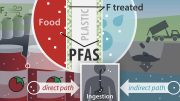
PFAS (Per- and polyfluoroalkyl substances), also known as “forever chemicals”, are a group of human-made chemicals that have gained attention due to their persistence, toxicity, and widespread presence in the environment. These synthetic compounds have been used in various consumer products, industrial applications, and firefighting foams. Concerns arise from their potential adverse effects on human health, including links to cancer, hormone disruption, and other harmful impacts on the immune and reproductive systems.
It is widely recognized that per- and polyfluoroalkyl substances (PFAS) cause significant health and environmental damage. However, recent research challenges the acclaimed stain-resistance advantages of these substances. The study, published in the AATCC Journal of Research, examined the efficacy of PFAS coatings on upholstery fabrics. The results indicated that their stain-prevention performance was negligible, especially in everyday real-world conditions.
“It was surprising that these harmful but supposedly indispensable chemicals had no practical benefit,” said lead author Jonas LaPier, a Ph.D. candidate in Civil and Environmental Engineering at Stanford University. “It makes you wonder what other uses of PFAS are also unnecessary and could be easily eliminated from products without a noticeable change in performance”
Using droplets of coffee and oil-based salad dressing, the researchers tested six PFAS-finished and three non-PFAS-finished fabrics used for indoor commercial furniture. For water-based coffee stains, none of the PFAS-finished fabrics performed better than the unfinished fabrics. The stains were minimal and easily removed from finished and unfinished fabrics alike. Only fabric type (e.g., polyester vs. cotton/nylon, patterned vs. unpatterned, light vs. dark, etc.) affected coffee stain performance.
For oil-based stains, some PFAS-finished fabrics showed minimal improvements over unfinished fabrics; however, the performance differences between fabric types were much larger than from PFAS finishes. Further, any repellency provided by the finishes were quickly lost with abrasion, meaning that the benefits would be lost as soon as the furniture is worn with use.
Exposures to PFAS from furniture occur during the manufacture, use, and disposal of finished fabrics, generating health risks for workers, consumers, and communities living near production sites as well as environmental harm.
Some PFAS have been associated with a wide range of serious health harms, from cancer to obesity to more severe COVID-19 outcomes, and they contaminate the drinking water of many millions. Only a small fraction of the thousands of PFAS have been tested for toxicity, and all PFAS are either extremely persistent in the environment or break down into extremely persistent PFAS. Additionally, some newer PFAS first claimed to be safe have been determined later to be harmful to our health.
“PFAS are a public health nightmare and should only be used when essential,” said Carol Kwiatkowski, co-author and scientist at the Green Science Policy Institute. “In the case of these fabrics, they aren’t delivering the desired performance of stain repellency, and like lipstick or car wax, they get reapplied, which introduces more PFAS into the environment and increases the risk of human exposure. There’s simply no justification for continuing to use them in furniture.”
“The results of the study align with what I’ve seen first-hand,” said co-author Betsy Phillips, Director of Environmental Initiatives of the textile company Maharam. “The presence of PFAS-based finishes doesn’t prevent textiles from staining, especially after the finishes have become worn with use. The best way to prevent staining is to promptly clean up spills. When prompt cleaning isn’t possible, choosing a thicker, darker, patterned fabric will help mask any stains that may permeate. Beyond staining, omitting PFAS is simply better for our health.”
Reference: “Evaluating the Performance of Per- and Polyfluoroalkyl Substance Finishes on Upholstery Fabrics” by Jonas LaPier, Arlene Blum, Brandon R. Brown, Carol F. Kwiatkowski, Betsy Phillips, Hannah Ray and Gang Sun, 3 April 2023, AATCC Journal of Research.
DOI: 10.1177/24723444231159856








Be the first to comment on "Are “Forever Chemicals” Really Useful? New Research Questions Their Effectiveness"